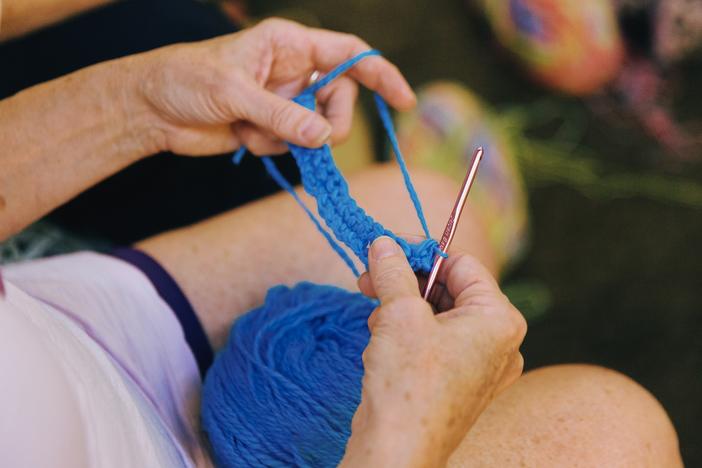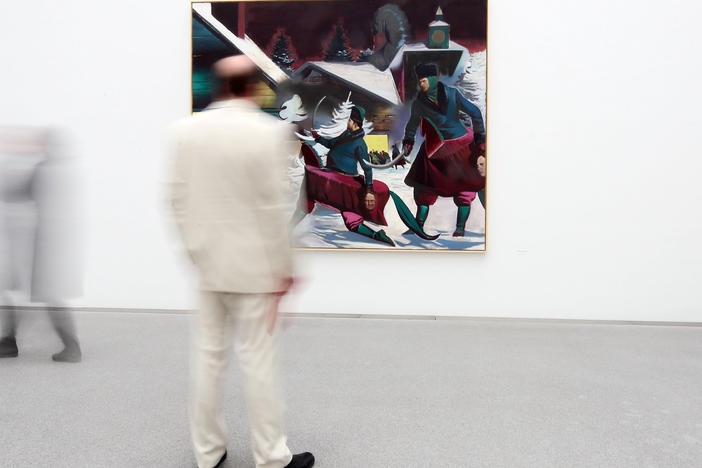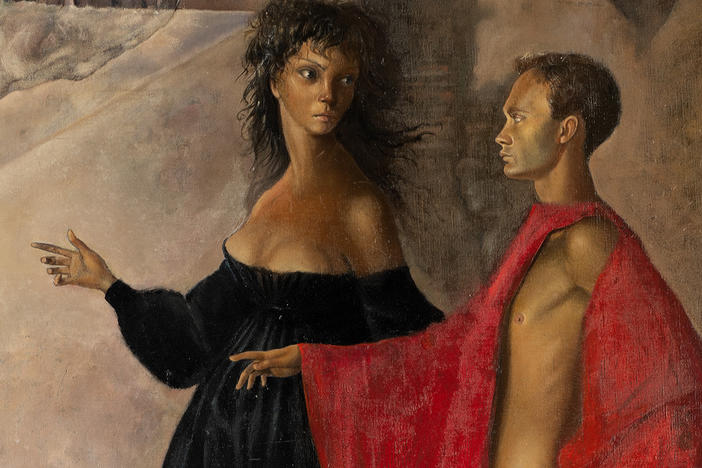Section Branding
Header Content
It Used To Be Just A Fence. It Became A Tribute To Things Lost And Found In 2020
Primary Content
A community art exhibit in suburban Maryland asked residents to consider a simple question: What have you lost, and what have you found in 2020?
Transcript
SACHA PFEIFFER, HOST:
As the year draws to a close, an art exhibit is asking residents of a Maryland neighborhood to consider this question - what was lost and what was found in 2020? NPR's Samantha Balaban visited the fence where the outdoor museum is located.
SAMANTHA BALABAN, BYLINE: It's just a regular, old, chain-link fence topped with barbed wire surrounding a parking lot, except that attached to the fence are what look like elaborate dioramas.
ANDREA JONES: You know, I've never made an outdoor exhibit like this before, so I wanted to make sure I could see it, you know?
BALABAN: Andrea Jones lives next door, and she's the curator of the exhibit called Community Lost and Found.
JONES: In my work, I do a lot of talking to museums about the potential to help people to process emotions.
BALABAN: Jones is a museum consultant who works for the Smithsonian Anacostia Community Museum. A couple months ago, she decided she wanted to do something that would help her reflect on this turbulent year.
JONES: You know, there's a lot of change happening. And in order to really process what's happening to us, I think it's really useful to do things, you know, physically, you know, with your hands.
BALABAN: So Jones built seven wooden boxes - they're a riff, she says, on the lost and found box you might find in school or a church - and asked her neighbors to help decorate them.
JONES: Can we walk over here? I can show you a little bit.
BALABAN: Jones walks over to a box designed by Megan Abbot and Gary Hall, who live across the street. This year, they had a baby.
JONES: And so what, you know, Megan and Gary found during this year was their daughter. So this is a real bird's nest that they put in this box.
BALABAN: She points to a pacifier suspended in a translucent globe.
JONES: And this kind of represents the bubble that they felt like they were in at that moment.
CECILY HABIMANA: So my box is - the name of it is called connection.
BALABAN: Cecily Habimana is the co-owner of the sewing studio Sew Creative Lounge. When the pandemic started, they had to close their doors.
HABIMANA: And even to this day, we only have about 20% of our students back into our studio.
BALABAN: So Habimana decorated a box with colorful swatches of fabric and strands of pearls suspended from the ceiling.
HABIMANA: And it basically shows that, you know, each person continues to do work, continues to sew at home and by themselves, but none of them are interacting with each other and that that connection has been lost.
BALABAN: Andrea Jones wanted everyone to be able to participate in this exhibit, so she also left out some pens and created little wooden tags so that people walking by can write on them and contribute.
JONES: Like drinking. Drinking - I gave it up during this year.
BALABAN: It's a living installation.
JONES: There's a special one that's dedicated to Ruth Bader Ginsburg, and it has these pearls draped on it.
BALABAN: Some of the things people have written on the tags are funny. One person wrote under the lost section, body fat. Others are poignant. A little kid writes under found - how to play with my brother.
JONES: Here's one that actually refers to the exhibit itself. I found these cutouts clanking in the breeze against an otherwise silent and nondescript eyesore chain-link fence and then smiled.
STEPHANIE VAUGHN: Oh, wow.
BALABAN: Stephanie Vaughn was leaving the parking lot when she stopped in front of the fence.
VAUGHN: This is really nice that the community would take the time out of their busy lives during this time to tell their story because every one of us has a story.
BALABAN: Vaughn works at a school in Baltimore County. It's been a tough year. In May, her mom was diagnosed with a brain tumor. Her husband died in September. When she was in South Carolina to help her family, she needed a project to do with her nieces.
VAUGHN: Well, OK. Let's keep this on the positive note.
BALABAN: When Vaughn picks up a tag, she writes about what she learned.
VAUGHN: Found - I started crocheting again. I made baby blankets and dishcloths. I enjoyed giving the gifts I made to family, friends and strangers.
BALABAN: After she tells her story and ties her tag to the fence, Vaughn heads to the post office to mail a package of her crochet just in time for the holidays. Samantha Balaban, NPR News.
(SOUNDBITE OF MUSIC) Transcript provided by NPR, Copyright NPR.
Correction
A previous version of this story incorrectly quoted Alicia Tarr as saying that she was "selling" masks, when in fact she said she was "sewing" masks.
Bottom Content



